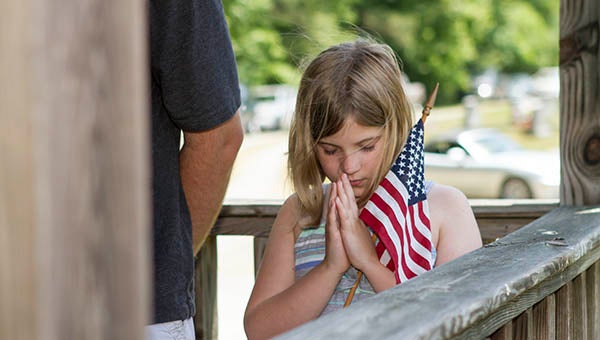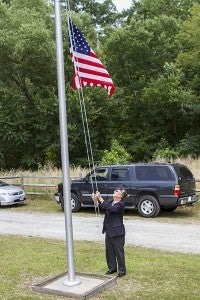American Legion gives special honors to women on Memorial Day
Published 1:19 pm Saturday, May 30, 2015

Laney Phillips, 9, of Franklin, prays as the Rev. Howard Vinson of Hunterdale Baptist Church offers the Invocation for the Charles R. Younts American Legion Post 73’s Memorial Day Ceremony on Monday. Vinson, the chaplain of Post 73, also told the story of the four chaplains who gave their life preservers and ultimately their lives as the SS Dorchester went down in WWII. — Cain Madden | Tidewater News
FRANKLIN
When American Legion Charles R. Younts Post 73 member Bob Springfield described Memorial Day, he said it’s an event that’s been becoming more inclusive ever since its inception after the American Civil War.
People in the South were not keen on observing Decoration Day, so after WWI it was renamed and rebranded as a day for all wars. In the 1970s, Springfield said the holiday — his favorite — changed again to be more inclusive to minorities in the military, including women.
To correct the all boys’ club, the Daughter’s of the American Revolution coined a list of 33 of the most influential women of the revolution. One of them was Laodicea “Dicey” Langston, and as Springfield pulled out a coin minted in her honor, he said to remember that name later in the service.

As Blaine Britt plays “Taps,” Kenny Gay, a member of the Charles R. Younts American Legion Post 73, lowers the flag to half mast in honor of the veterans who gave the ultimate sacrifice. Cain Madden | Tidewater News
Introducing Kim Bauhs, a retired veteran of the U.S. Navy’s nuclear power program, Springfield couldn’t help but be a little proud as he listed off her accomplishments. After the Navy, the places she has served include the White House, Immigration and Customs Enforcement and, now, human resources director for the National Oceanographic and Atmospheric Administration.
“The speaker, Mrs. Kim Bauhs, happens to be my daughter,” Springfield said with a smile. “We’ve asked her here to speak about women in the military.”
Women served in various non-combat roles during the World Wars, including more than 400,000 during WWII abroad and at home as mechanics, ambulance drivers, pilots, administrators and nurses. After WWII, Congress passed the Women’s Armed Services Integration Act, but things really began to change in 1973. That was the end of the draft and the institution of the all-volunteer military.
In 1976, the military academies opened up their doors to women, and Bauhs said her father wanted her to consider joining the U.S. Naval Academy.
“Throughout my childhood, my dad always encouraged me to follow my passions — he saw no boundaries or limitations, no glass ceilings — only opportunities for women,” she said, adding that she was grateful for his support, though ultimately she decided to attend the College of Charleston to study mathematics. She was commissioned in the Navy in 1983.
“This more traditional path suited me as an 18-year old,” she said. “While I never look back with regrets, I often wonder how life might have been different with more bold choices!”
For example, one ground breaker was Michelle Howard, who graduated high school one year before Bauhs. She was accepted in 1978 to the U.S. Naval Academy, and went on to oversee counter-piracy operations in the Gulf of Aden.
“If you saw the movie ‘Captain Philips,’ she led the recovery of Capt. Phillips after Somali pirates attacked the cargo ship, Maersk Alabama,” Bauhs said. “Last July, Navy Secretary Ray Mabus pinned a Fourth Star on Adm. Howard, making her the first female Four-Star Admiral — and the highest-ranking African-American woman ever in the military.”
Women have been serving in combat roles for a long time, including Deborah Samson Gannet of Plymouth, Mass., who was one of the first female soldiers. She enlisted in 1782 under the name of her deceased brother, Robert Samson.
“For 17 months during the Revolutionary War, Samson served in the Continental Army and fought for independence,” Bauhs said. “She was wounded twice and cut a musket ball out of her own thigh so a doctor wouldn’t find out she was a woman. In 1804, she was awarded a pension for her service.”
Traditionally, women have been restricted from serving in combat roles, but over time that’s changed. In the 1990s, women were authorized to fly in combat missions and serve on ships. In 2013, the Pentagon announced plans for fully integrating women into front-line and special combat rolls by 2016, including the elite forces such as Army Rangers and Navy SEALs.
“Last month, 16 women joined the first co-ed Ranger course at Ft. Benning,” Bauhs said. “I don’t expect their path will be easy.”
Bauhs couldn’t forget her fifth grandmother, Dicey Langston, who grew up during the American Revolution in rural South Carolina, surrounded by British loyalists.
When her brothers left the plantation to fight with the Continental Army, Dicey was left surrounded by many friends and relatives who were loyalists. So much so that she often overheard British plans of attack.
“Whenever Dicey found out information about what the loyalists were going to do, she would ride her horse to warn the people who would be affected,” Bauhs said. “Some refer to her as the female Paul Revere for her historic ride, twice as long as Paul’s, to warn of a planned attack by the ‘Bloody Scouts’ at daybreak.”
The Tory outlaws, led by Bloody Bill Cunningham, were known for ruthless cruelty to families who sympathized with the rebel cause. She was able to warn her brother of an attack, and then later stepped in front of the Bloody Scouts to save her father, Solomon.
“Displayed on the wall in our home in Germantown, Maryland, is an image of this scene — of Dicey protecting her father from the Bloody Scouts,” Bauhs said. “Dicey is an important example of the courage displayed by those patriots at the beginning of our United States of America. Her courage and patriotism show each of us that one person can make a difference — no matter their age or gender.”
While commemorating those who lost their lives in sacrifice to the country, she said to also remember the women, children and families who loved them and endured these sacrifices.
“We also acknowledge all the brave men and women who have stepped up and said ‘Yes,’ to military service,” Bauhs said. “Irrespective of gender, race and other irrelevant distinctions, they have chosen to put country first and promise to keep us safe.”





